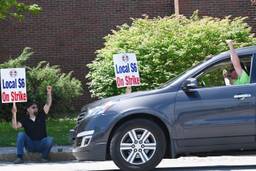Leave it to the United States to buck another progressive global trend: urban bicycle riding. While worldwide bicycle production has been steadily increasing since 1970 - last year, 130 million bikes were built, versus 52 million cars - U.S. bike ridership has dropped 32 percent since 1990. Biking accounts for only .4 percent of Americans' trips to work, and .9 percent of all trips.
That's according to a new Earth Policy Institute report, which, after reminding us that Europeans like to bike, notes:
Governments elsewhere are following Europe’s lead. Bogotá, Colombia, boasts more than 300 kilometers of bikeways, the most for a city in the developing world. In Australia, the state of Victoria has amended planning laws to require all new large buildings to provide bike parking and other facilities such as showers and lockers. And in November 2007, South Korea’s Home Affairs Ministry announced a new pro-bike campaign to alleviate increasing traffic and air pollution and to cope with soaring oil prices. As it expands bicycle infrastructure, the government aims to substantially increase bike ownership by 2015, from one bike for every seven citizens to one for every four.
Some notoriously polluted and congested cities are working to reap the benefits of cycling as well. Mexico City plans to have 5 percent of all trips be by bike in 2012, up from less than 2 percent today, using traffic calming methods, promotional campaigns, and bike-transit connectivity. In India, Delhi’s newest Master Plan requires fully segregated bicycle tracks on all arterial roads and notes that promoting cycling will be an essential component of the city’s plans to reduce growth in fossil fuel consumption.
Encouraging signs at home though:
Despite these unimpressive statistics, encouraging signs can be seen for the future of cycling in the United States. Aided by $900 million a year in federal funding for promotion of biking and walking for 2005 to 2009, the installation of bicycle facilities—including parking, bike-friendly roads, and designated lanes—is proceeding at a record pace. Indeed, plans in the 50 largest U.S. cities would, on average, double their bicycle and pedestrian routes; New York City alone will quadruple its bike network to 2,900 kilometers by 2030… Bicycle advocacy in the United States continues to grow as well.
Investment and advocacy are one thing. But change en masse - a commuting paradigm shift - is another. If cities build the cycling infrastructure, will commuters come?
Jeremy Gantz is an In These Times contributing editor working at Time magazine.





